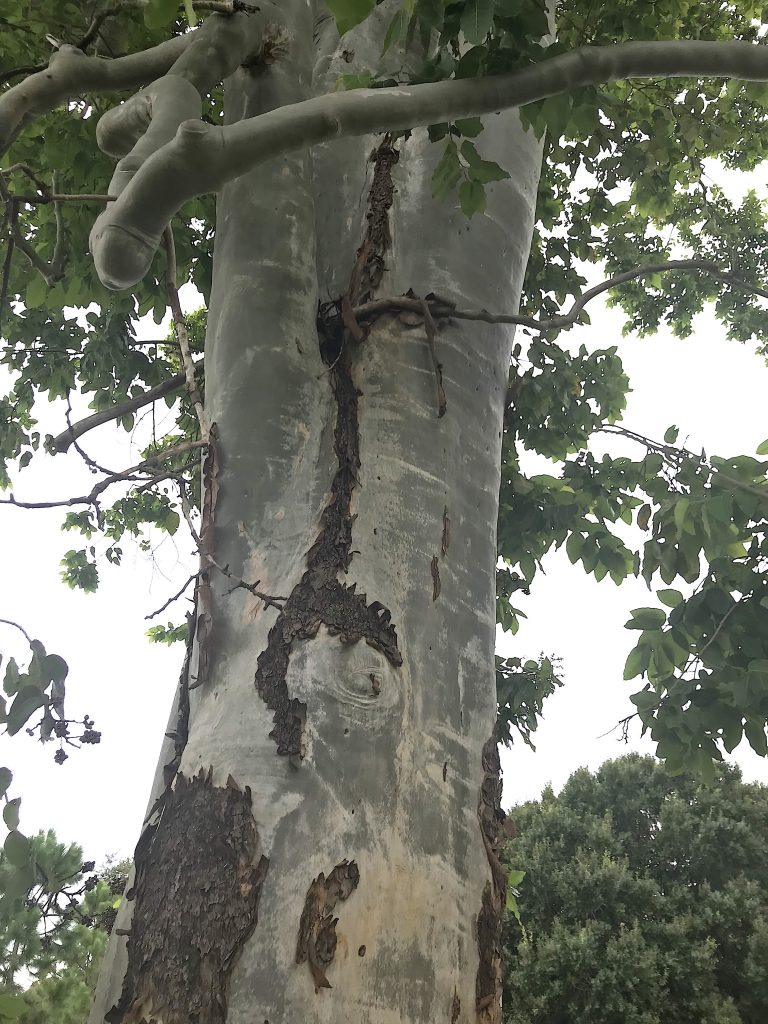
If you’re thinking Eucalyptus you’re close. Photo by Green Deane
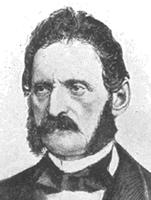
Count Torelli had the bright idea of using eucalyptus trees to drain malarial swamps.
I add about one new species a month to my data base. After a class Saturday in southwest Florida a gentleman asked me to look at a tree he was having a hard time identifying. Like him I, too, had no idea what it was though I could guess where it was from and some of its relatives.
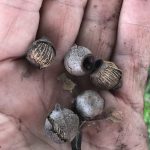
The seeds are not edible. Photo by Green Deane
On Drance Street in Port Charlotte, the tree is very tall. It immediately reminds one of a eucalyptus. I first thought it was an Alectryon excelsus, or the Titoki tree from New Zealand. My only problem with that was the Titoki tree is a sub-canopy species to 30 feet. This tree far exceeds that height and not all the leaves were right. After a lot of rummaging I have settled on Corymbia torelliana. It used to be called Eucalyptus torelliana. Corymbia is from corym, a flower cluster. Torelliana honors Count Luigi de Torelli of the Italian senate (d. 1887) who promoted the use of eucalyptus to dry the malarial Pontine mashes near Rome.
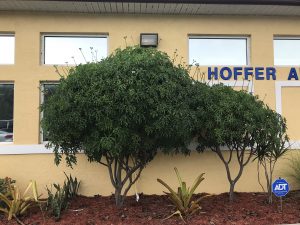
There were several Chaya shrubs nearby. Photo by Green Deane
Aboriginal names for the tree are Cadaga and Cadaghi. Australians also call it the Blood-Leaf Gum. It is also known as Torell’s eucalyptus. Originally brought to Florida for windbreaks they can grow 50 feet in 20 years. Adult height is between 90 and 100 feet. For a windbreak they are planted six to 10 feet apart in a single row. As it grows straight and tall it requires little if any pruning. The tree is useful for honey production. Interestingly the building near the tree in Port Charlotte has several planted Chaya shrubs. They have leaves that are edible cooked. (Pick with gloves and long sleeves on as they are related to our stinging Spurge Nettle.) You can read about Chaya here.
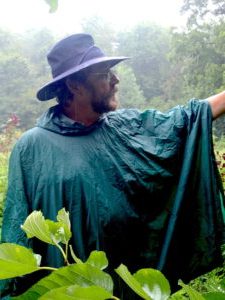
Classes are held rain or shine (but not during hurricanes.)
Scheduling foraging classes is iffy this time of year. It can be truly too hot in the southern end of the state for a three-hour class. One also has to outguess the weather and look long term whereas in the fall one can book out three months. Last Saturday Tropical Storm Fred decided to stay south a few hours longer and we had a cloud-covered but dry class in Port Charlotte. The trip north, however, was drenching. Saturday’s class is in Largo, always a nice location to visit. It used to be a working farm. Sunday’s class is not held too often and is about 10 miles north of downtown Orlando at Sanlando Park. We skirt some athletic fields and visit the Little Wekiva. It’s also a location that often has huge amount of Creeping Cucumber.
Saturday August 21st, Eagle Park Lake, 1800 Keene Road, Largo, FL 33771. 9 a.m. to noon. Meet at the pavilion near the dog park.
Sunday August 22nd, Seminole Wekiva Trail, Sanlando Park, 401 West Highland St. Altamonte Springs, Florida 32714 (at the intersection with Laura Avenue.) We meet in the first parking lot on your right immediately after the entrance. 9 a.m. to noon.
Saturday August 28th, Boulware Springs Park, 3420 SE 15th St., Gainesville, FL 32641. Meet at the picnic tables next to the pump house. 9 a.m. to noon.
Sunday August 29th, Mead Garden: 1500 S. Denning Dr., Winter Park, FL 32789. Meet at the bathrooms. 9 a.m to noon.
For more information, to pre-pay or sign go here.
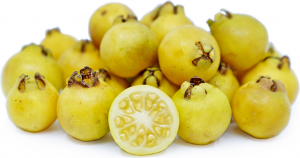
Guavas are common around old Florida homesteads.
The other surprise this week came at a private class west of Daytona Beach. A shrub had one, shriveling, fruit. As with the tree above one could guess its relatives. I used to have a Strawberry Guava and this fruit was similar except larger and a different color. However the shape, texture and flavor was right. Most likely it was intentionally planted as there were two Loquats nearby and a Bauhinia nearby (the latter has edible blossoms.) Again after some digging I settled on Psidium littorale (said SID-ee-um lit-aw-RAY-lee) the Lemon Guava or P. guajava (a closer look at the leaves should sort that out.) They are usually found in south Florida and are native to Brazil. The fruit contains a high amount of vitamin A and folate. It also has vitamins C (with higher concentrations in the skin) and B-complex vitamins as well as potassium. It also provides flavonoids, terpenoids, carotene, lycopene, soluble fibers, and amino acids. It was a nice find. Leaf tea has been used to reduce blood glucose levels. The species grows easily from seeds and fruits in about seven years. In many areas the Guavas are invasive.
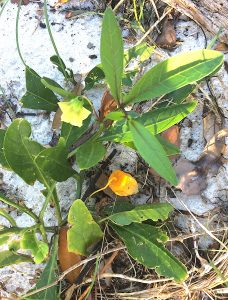
As the Ground Cherry ripens the husk turns golden. Photo by Green Deane
It was fruit day Saturday during our class in Port Charlotte. The mangoes were done but the Java Plum (Jambul) was just starting and Star Fruit littered the ground. A great tasty surprise was many ground cherries. There are several species locally and those were Physalis viscosa. I pocketed some seeds for planting. Also fruiting in profusion were coco-plums. There were so many I picked ten pounds and will try to make a couple experimental gallons of wine. Also fruiting was the Natal Plum which is not really a plum but a close relative to the toxic Oleander. All parts of the Natal Plum are toxic except the ripe fruit. We also got to taste some non-commercial Dragon Fruit from some candle cactus. The Podocarpus is ripening, too. It clearly is the time of year to look for wild edible fruit.
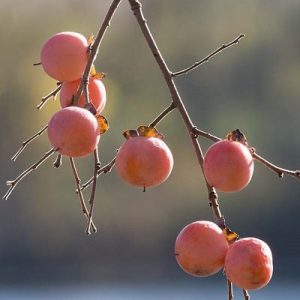
One can find ripe persimmons from late August to early January though October is a good target month. Photo by Green Deane
During Sunday’s class at Blanchard Park we got to see a fruiting Persimmon Tree up close and personal. They are mostly green this time of year but one has to ripen before the others. While we aim for October for ripe persimmon sometimes you can find one or two already ripe this time of year. Persimmons are much maligned because they are astringent until extremely ripe. From the tree’s perspective it does not want the fruit carried away by animals that can taste sweet until the seeds are ready to germinate. So the fruit stays non-palatable to most creatures until the last moment. The fruit seemingly turns sweet overnight. No frost is needed. The best persimmons are the ones you have to fight the ants for. The place to look for Persimmons trees are along edges…. edges of forests, edges of roads and rivers and paths. To read more about the Persimmon, which is North American’s only ebony, go here.

Green Deane videos are now available on a USB.
My nine-DVD set of 135 videos has been phased out and replaced by a 150-video USB. The USB videos are the same videos I have on You Tube. Some people like to have their own copy. The USB videos have to be copied to your computer to play. If you want to order the USB go to the DVD/USB order button on the top right of this page or click here. That will take you to an order form. I’d like to thank all of you who ordered the DVD set over the years which required me to burn over 5,000 DVDs individually.

Green Deane Forum
Want to identify a plant? Perhaps you’re looking for a foraging reference? You might have a UFO, an Unidentified Flowering Object, you want identified. On the Green Deane Forum we — including Green Deane and others from around the world — chat about foraging all year. And it’s not just about warm-weather plants or just North American flora. Many nations share common weeds so there’s a lot to talk. There’s also more than weeds. The reference section has information for foraging around the world. There are also articles on food preservation, and forgotten skills from making bows to fermenting food.
 Your donations to upgrade the EatTheWeeds website and fund a book were appreciated. A book manuscript has been turned it. It had 425 articles, 1326 plants and a third of a million words. What it will be when the publisher is done with it next year is unknown. It will be published in the spring of 2023. Writing it took a significant chunk of time out of my life from which I have still not recovered. (Many things got put off.) The next phase is to update all the content on the website between now and publication date. Also note as it states above the 135-video DVD set has been phased out for 150-video USB. Times and formats change. Which reminds me I need to revisit many plants and make some new videos.
Your donations to upgrade the EatTheWeeds website and fund a book were appreciated. A book manuscript has been turned it. It had 425 articles, 1326 plants and a third of a million words. What it will be when the publisher is done with it next year is unknown. It will be published in the spring of 2023. Writing it took a significant chunk of time out of my life from which I have still not recovered. (Many things got put off.) The next phase is to update all the content on the website between now and publication date. Also note as it states above the 135-video DVD set has been phased out for 150-video USB. Times and formats change. Which reminds me I need to revisit many plants and make some new videos.
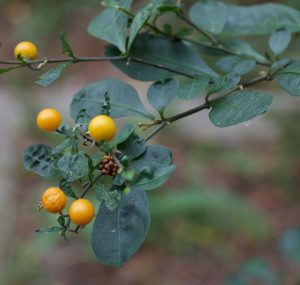
The controversial two-leaf nightshade. Photo by Green Deane
And what are we to do with the Two-Leaf Nightshade, Solanum diphyllum? This native to Mexico and Central America was first spied in the United States in Miami in the early to mid-1960s. It has spread since then and is a common shrub in south and Central Florida as well as parts of Texas and in southern France, Italy and Taiwan. It’s almost always reported as toxic. I wrote “almost” because people tell me they have eaten a few ripe berries without noticeable issue. They have also eaten them in my classes with several witnesses. Our usual sources of plant expertise are no help with this greenery: Daniel Austin in his tome Florida Ethnobotany doesn’t mention the plant though he was a professor of botany in south Florida when the species was proliferating. His University of Miami boss, the crusty Yankee Julia Morton, doesn’t do us much better.
In her book Plants Poisonous To People in Florida she calls it Amatillo. Instead of having it in the main section of the book it’s in the back under “other toxins.” After a description she writes: “The ripe fruit is sweetish, not acrid like the Jerusalem Cherry, but the green fruit and leave probably contain solanine.” She adds “In one pasture, where there were several of these bushes, a horse had optical abnormality, was staggering and weak in the hindquarters and may have grazed on the foliage.” I think that means don’t eat the leaves. Morton finishes her entry with “We must regard it with suspicion until we have actual evidence of toxicity.” I would add the species in not mentioned in the Journal of Economic Botany which spans some seven decades and was created to bring lesser-known plants to public attention and use.
Not only is there a dearth of credible references regarding edibility reports fall short in the medicinal realm as well. An “Amatillo” is mentioned in Duke’s Handbook of Medicinal Plants of Latin America. Unfortunately it is a totally different species, Rauvolfia tetraphylla. Apparently there are several species commonly called “Amatillo.” No doubt there is a grandmother in Central America who knows exactly what to do with Solanum diphyllum fruit. The species is conspicuously missing from several publications about fruit in tropical climates. As a Nightshade it probably has some uses. The species might be mentioned in some Spanish texts but while I can misspell in two languages Spanish is not one of them.
This is weekly newsletter #470. If you want to subscribe to this free newsletter you can find the sign-up form in the menu at the top of the page.
To donate to the Green Deane Newsletter click here.


I am very appreciative that you took the time to look at the large tree in Port Charlotte and then research and write such a wonderful article not only about it, but the Chaya shrubs and all the great plants we tried at Bayshore Park. Your expertise is amazing. Thank you! May God Bless you and and protect you especially during your travels to help others.
Thank you for your kind words.